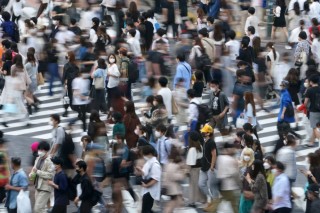Loading
Search
▼ Japan Business Investment Rose 1.2% On Year From July To September
- Category:Other
Capital spending by companies in Japan rose 1.2% in the July-September period from a year earlier, up for the second straight quarter, but growth was slow as some firms hesitated to invest amid the coronavirus pandemic, government data showed Wednesday.
Investment by all nonfinancial sectors for purposes such as building factories and adding equipment totaled ¥10.93 trillion ($96 billion), according to the Finance Ministry.
Capital expenditure by manufacturers edged up 0.9% to ¥3.92 trillion, increasing for the second consecutive quarter, as some makers of metal products made investments they had postponed due to the pandemic.
In the nonmanufacturing sector, spending grew 1.4% to ¥7.01 trillion, led by expenditures in the service sector including accommodation operators and restaurants that are bouncing back from a sharp downturn in the previous year.
However, seasonally adjusted capital expenditure by all nonfinancial sectors, including spending on software, declined 2.6% from the second quarter of 2021 for the first drop in three quarters.
The fall was led by retailers postponing investments as they saw a decline in customers with the country facing a resurgence of COVID-19 cases in the reporting quarter, a government official said. Many prefectures were under a state of emergency during the three-month period.
"The results indicate the overall economy is showing weakness in the pace of its recovery in difficult circumstances amid the pandemic," the official said.
Private-sector economists said the fall in seasonally adjusted capital expenditure was due to a spike in COVID-19 cases and production cuts by major automakers — affected by factory shutdowns in Southeast Asia that disrupted supply chains and a global semiconductor shortage.
"Manufacturers were forced to postpone capital spending amid supply constraints on transportation equipment," said Yoshimasa Maruyama, chief economist at SMBC Nikko Securities Inc. He expected a recovery in the October-December quarter as the supply constraints are easing.
Taking into account the latest capital spending figures, the Cabinet Office is scheduled to release revised gross domestic product data for the same quarter on Dec. 8.
Preliminary data showed the country's economy shrank an annualized real 3.0% in the three-month period, for the first decrease in two quarters.
Maruyama forecast the July-September GDP figure will be revised downward to an annualized 3.4% contraction as the business investment component is expected to be downgraded.
Pretax profits at companies included in the ministry's survey soared 35.1% to ¥16.75 trillion, up for the third straight quarter, lifted by the information and communication electronics equipment sector that makes parts for vehicles.
Sales rose 4.6% to ¥323.57 trillion, gaining for the second consecutive quarter, as chemical product makers met brisk demand for components used in semiconductors.
The ministry surveyed 32,460 companies capitalized at ¥10 million or more, of which 22,883, or 70.5%, responded.
Investment by all nonfinancial sectors for purposes such as building factories and adding equipment totaled ¥10.93 trillion ($96 billion), according to the Finance Ministry.
Capital expenditure by manufacturers edged up 0.9% to ¥3.92 trillion, increasing for the second consecutive quarter, as some makers of metal products made investments they had postponed due to the pandemic.
In the nonmanufacturing sector, spending grew 1.4% to ¥7.01 trillion, led by expenditures in the service sector including accommodation operators and restaurants that are bouncing back from a sharp downturn in the previous year.
However, seasonally adjusted capital expenditure by all nonfinancial sectors, including spending on software, declined 2.6% from the second quarter of 2021 for the first drop in three quarters.
The fall was led by retailers postponing investments as they saw a decline in customers with the country facing a resurgence of COVID-19 cases in the reporting quarter, a government official said. Many prefectures were under a state of emergency during the three-month period.
"The results indicate the overall economy is showing weakness in the pace of its recovery in difficult circumstances amid the pandemic," the official said.
Private-sector economists said the fall in seasonally adjusted capital expenditure was due to a spike in COVID-19 cases and production cuts by major automakers — affected by factory shutdowns in Southeast Asia that disrupted supply chains and a global semiconductor shortage.
"Manufacturers were forced to postpone capital spending amid supply constraints on transportation equipment," said Yoshimasa Maruyama, chief economist at SMBC Nikko Securities Inc. He expected a recovery in the October-December quarter as the supply constraints are easing.
Taking into account the latest capital spending figures, the Cabinet Office is scheduled to release revised gross domestic product data for the same quarter on Dec. 8.
Preliminary data showed the country's economy shrank an annualized real 3.0% in the three-month period, for the first decrease in two quarters.
Maruyama forecast the July-September GDP figure will be revised downward to an annualized 3.4% contraction as the business investment component is expected to be downgraded.
Pretax profits at companies included in the ministry's survey soared 35.1% to ¥16.75 trillion, up for the third straight quarter, lifted by the information and communication electronics equipment sector that makes parts for vehicles.
Sales rose 4.6% to ¥323.57 trillion, gaining for the second consecutive quarter, as chemical product makers met brisk demand for components used in semiconductors.
The ministry surveyed 32,460 companies capitalized at ¥10 million or more, of which 22,883, or 70.5%, responded.
- December 3, 2021
- Comment (0)
- Trackback(0)


